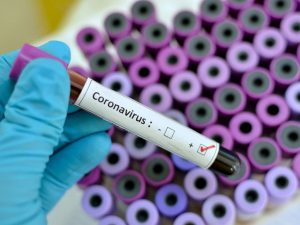
COVID-19 is a new illness that can affect your lungs and airways. It’s caused by a virus called coronavirus.
A deadly new coronavirus that emerged in China in late December has spread to more than 160 countries on six continents, with the World Health Organization (WHO) declaring the pathogen a global pandemic.
Many health experts believe that the new strain of coronavirus likely originated in bats or pangolins. The first transmission to humans was in Wuhan, China. Since then, the virus has mostly spread through person-to-person contact.
Coronaviruses are a group of viruses that can cause disease in both animals and humans. The severe acute respiratory syndrome (SARS) virus strain known as SARS-CoV is an example of a coronavirus. SARS spread rapidly in 2002–2003.
The new strain of coronavirus is called severe acute respiratory syndrome coronavirus 2 (SARS-CoV-2). The virus causes coronavirus disease 19 (COVID-19).
Around 80% of people with COVID-19 recover without specialist treatment. These people may experience mild, flu-like symptoms. However, 1 in 6 people may experience severe symptoms, such as trouble breathing.
The new coronavirus has spread rapidly in many parts of the world. On March 11, 2020, the World Health Organization (WHO) declared COVID-19 a pandemic. A pandemic occurs when a disease that people are not immune to spreads across large regions.
Read on to learn more about the suspected cause of coronavirus and how it spreads.
What caused coronavirus?
The recent outbreak began in Wuhan, a city in the Hubei province of China. Reports of the first COVID-19 cases started in December 2019.
Coronaviruses are common in certain species of animals, such as cattle and camels. Although the transmission of coronaviruses from animals to humans is rare, this new strain likely came from bats, though one study suggests pangolins may be the origin.
However, it remains unclear exactly how the virus first spread to humans.
Some reports trace the earliest cases back to a seafood and animal market in Wuhan. It may have been from here that SARS-CoV-2 started to spread to humans.
How it spreads
SARS-CoV-2 spreads from person to person through close communities.
When people with COVID-19 breathe out or cough, they expel tiny droplets that contain the virus. These droplets can enter the mouth or nose of someone without the virus, causing an infection to occur.
The most common way that this illness spreads is through close contact with someone who has the infection. Close contact is within around 6 feet.
The disease is most contagious when a person’s symptoms are at their peak. However it is possible for someone without symptoms to spread the virus. A new study suggests that 10% of infections are from people exhibiting no symptoms.
Droplets containing the virus can also land on nearby surfaces or objects. Other people can pick up the virus by touching these surfaces or objects. Infection is likely if the person then touches their nose, eyes, or mouth.
It is important to note that COVID-19 is new, and research is still ongoing. There may also be other ways that the new coronavirus can spread.
Is it more dangerous than other viruses?
Most cases of COVID-19 are not serious. However, it can cause symptoms that become severe, leading to death in some cases.
The outbreak of COVID-19 has been sudden. This makes it difficult to estimate how often the disease becomes severe or the exact rate of mortality.
One report suggests that out of 1,099 people with confirmed cases in China, around 16% became severe. Another report estimates that about 3.6% of the confirmed cases in China led to death.
These figures are likely to change as the situation evolves. However, they suggest that COVID-19 is more deadly than influenza. For example, seasonal influenza typically leads to death in less than 0.1% of cases.
When testing becomes easier and more widespread, health experts will have a more accurate insight into the exact number of severe cases and deaths.
SARS is another type of coronavirus. It became a global pandemic in 2002–2003. Around 9.6% of SARS cases led to death. However, COVID-19 is more contagious, and it is already the cause of more deaths worldwide.’
Risk factors
Some factors can affect the risk of coming into contact with the virus, while other factors can affect the risk of developing severe illness.
The risk of coming into contact with the virus depends on how far it has spread in a person’s local area.
The WHO state that the risk of developing COVID-19 is still low for most people. However, this is changing as the virus spreads — particularly in Europe and the United States.
The risk is higher for anyone in close contact with people who have COVID-19, such as healthcare workers. Viruses can also spread more in certain areas, such as highly populated cities.
Those most at risk of severe illness are older adults and people with chronic health conditions, such as high blood pressure, heart or lung disease, or diabetes
Symptoms of coronavirus disease
The symptoms are general and very variable. The following symptoms can occur:
- Cough (usually dry)
- Sore throat
- Shortness of breath
- High temperature, feverishness
- Muscle ache
More rarely:
- Headache
- Gastrointestinal symptoms
- Head cold
The symptoms can vary in severity. Complications such as pneumonia are also possible.
Can the illness be treated?
At the moment there is no specific treatment for the disease caused by the coronavirus. Treatment is limited to easing the symptoms. To protect other people, those infected are placed in isolation. In serious cases, patients usually require intensive care, which may involve artificial ventilation.
Symptoms from a coronavirus infection cannot be treated with antibiotics, because antibiotics are effective only against bacteria, not against viruses.
Is this a global emergency?
Yes, this outbreak is a global health emergency, the WHO said on January 30, raising the alarm further on March 11 when it declared the crisis a pandemic.
The international health alert is a call to countries around the world to coordinate their response under the guidance of the WHO.
There have been five global health emergencies since 2005 when the declaration was formalised: swine flu in 2009, polio in 2014, Ebola in 2014, Zika in 2016 and Ebola again in 2019.
Outlook
Most people who develop COVID-19 only experience mild symptoms. These symptoms may build up slowly and should go away after a few days.
It is important for anyone who may have COVID-19 to contact their healthcare provider. For those with mild symptoms, call a doctor over the phone for medical advice.
It is essential to contact the emergency services if any of the following symptoms occur:
- difficulty breathing
- lasting chest pain or pressure
- confusion
- a bluish tint to the lips or face
Prevention
People’s Are Reading: How to Protect Yourself From COVID 19 (Coronavirus)
Thanks for viewing this All you need to know about Coronavirus – origin and how it spreads! Don’t forget to share them with your friends on social media.
sources:
- WHO Director-General’s opening remarks at the media briefing on COVID-19 – 11 March 2020. (2020).
https://www.who.int/dg/speeches/detail/who-director-general-s-opening-remarks-at-the-media-briefing-on-covid-19—11-march-2020 - Coronavirus disease 2019 (COVID-19): Situation report – 46. (2020).
https://www.who.int/docs/default-source/coronaviruse/situation-reports/20200306-sitrep-46-covid-19.pdf?sfvrsn=96b04adf_2 - Coronavirus disease 2019 (COVID-19): Situation summary. (2020).
https://www.cdc.gov/coronavirus/2019-ncov/cases-updates/summary.html - Guan, W.-J., et al. (2020). Clinical characteristics of coronavirus disease 2019 in China.
https://www.nejm.org/doi/full/10.1056/NEJMoa2002032 - Q&A on coronaviruses (COVID-19). (2020).
https://www.who.int/news-room/q-a-detail/q-a-coronaviruses - What is coronavirus? (n.d.).
https://www.hopkinsmedicine.org/health/conditions-and-diseases/coronavirus
https://www.medicalnewstoday.com/articles/coronavirus-causes
https://www.bag.admin.ch/bag/en/home/krankheiten/ausbrueche-epidemien-pandemien/aktuelle-ausbrueche-epidemien/novel-cov/krankheit-symptome-behandlung-ursprung.html
https://www.aljazeera.com/news/2020/01/coronavirus-symptoms-vaccines-risks-200122194509687.html


















